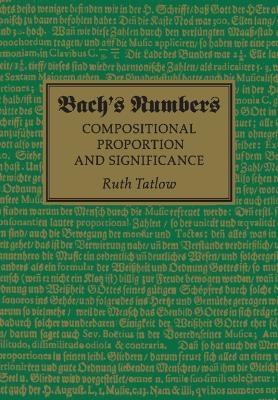
Bach's Numbers
Cambridge University Press (Verlag)
978-1-107-45969-4 (ISBN)
In eighteenth-century Germany the universal harmony of God's creation and the perfection of its proportions still held philosophical, moral and devotional significance. Reproducing proportions close to the unity (1:1) across compositions could render them beautiful, perfect and even eternal. Using the principles of her groundbreaking theory of proportional parallelism and the latest source study research, Ruth Tatlow reveals how Bach used the number of bars to create numerical perfection across his published collections, and explains why he did so. The first part of the book illustrates the wide-ranging application of belief in the unity, showing how planning a well-proportioned structure was a normal compositional procedure in Bach's time. In the second part Tatlow presents practical demonstrations of this in Bach's works, illustrating the layers of proportion that appear within a movement, a work, between two works in a collection, across a collection and between collections.
British-Swedish musicologist Ruth Tatlow is an independent scholar based in Stockholm. Her research into Bach's use of numbers led from her classic monograph Bach and the Riddle of the Number Alphabet (Cambridge, 1991) to its sequel Bach Numbers, through publications on methodology, inventive techniques and the theory of proportional parallelism. In 2004 she co-founded Bach Network UK (BNUK), establishing its open access web-journal Understanding Bach in 2006. She is currently Chair of the BNUK Council, joint editor of Understanding Bach, and a member of the Editorial Board of the American Bach Society. Her research has attracted awards and grants from numerous sources including the Swedish Research Council, the Royal Swedish Academy of Music, the Society of Authors of Great Britain, the British Council, The Hinrichsen Foundation, The Leverhulme Trust and the Royal Swedish Academy of Letters.
Part I. Foundations: 1. Bach's numbers; 2. Symmetry, proportion and parallels; 3. Unity, proportions and universal harmony in Bach's world; 4. Bars, compositional planning and proportional parallelism; Part II. Demonstrations: 5. Three collections for strings; 6. Four in two collections for keyboard; 7. Two further collections for keyboard; 8. Two small late collections; 9. Two large late collections; 10. Collections of concertos; 11. Collections of organ works; 12. Great passions and cantatas; 13. Festive cut-and-paste projects: masses and oratorios; 14. Lost blueprints; Appendix 1. Chronological index of musical doctrine.
| Erscheinungsdatum | 12.10.2016 |
|---|---|
| Zusatzinfo | 119 Tables, black and white; 8 Halftones, black and white; 1 Line drawings, black and white |
| Verlagsort | Cambridge |
| Sprache | englisch |
| Maße | 169 x 244 mm |
| Gewicht | 730 g |
| Themenwelt | Kunst / Musik / Theater ► Musik ► Klassik / Oper / Musical |
| Geschichte ► Teilgebiete der Geschichte ► Kulturgeschichte | |
| Mathematik / Informatik ► Mathematik ► Geschichte der Mathematik | |
| ISBN-10 | 1-107-45969-9 / 1107459699 |
| ISBN-13 | 978-1-107-45969-4 / 9781107459694 |
| Zustand | Neuware |
| Haben Sie eine Frage zum Produkt? |
aus dem Bereich


